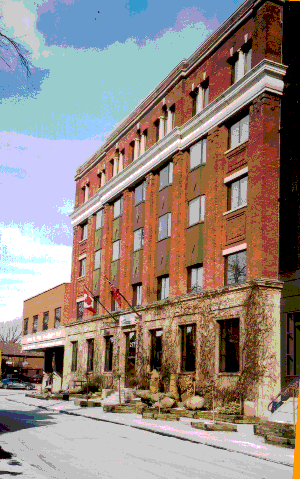This factory, now owned by Cadbury, was originally the Neilson plant. It is five stories high, with 433,373 square feet of floor space and a fine example of early twentieth century industrial architecture. It is an important employer in this part of the city. There are about 600 employees working in the plant, many of which are of Portuguese extraction. This came about because many immigrants from Portugal settled in this part of Toronto after the Second World War. It is of interest to note that both the Cadbury and the Neilson enterprises started as quite small family businesses. The former in Birmingham England, in 1824, and the latter in Toronto in the 1890s. This factory was built by the Neilsons and this is their story.

William Neilson was born in 1844, on his father’s farm in Almonte, the eldest of the 12 children. In 1865, he left the farm to make a new life, first in Rochester, New York and then, in 1867, in Ontario. In October 1875, he married Mary Eva Kaiser. Together they ran a small drygoods shop in Brockville; however, after four years of sluggish retail trade, he sold the store and relocate his family to Toronto, where he tried the grocery business. Unfortunately he went bankrupt due to extending too much credit to customers who took advantage of him. To support his family, he headed west to work as a harvester in North Dakota, sending his wages back to Toronto.
His wife, Mary, found that she needed more than the wages of a fieldhand to support their five children. A resourceful woman, Mary Neilson rented a house on four acres of land, on Lynd Avenue in Parkdale and began growing her own fruits and vegetables.
By the time William returned to Toronto, Mary had established a small business selling home-made mincemeat. They were lean years. William sold the mincemeat to local retailers, while their son, Morden, helped by milking the cows and selling the milk to neighbours. He delivered the milk in tin pails on his way to school and picked up the empties on the way home.
William became convinced that he could build a successful ice cream business. He bought three hand-cranked ice cream freezers on credit, and set them up in a barn on the Lynd Avenue property and put them into working order. The first batch of Neilson ice cream was produced on May 24, 1893. Using pure cream instead of milk (used by most producers then) and churning the ice cream very rapidly, he was able to produce very smooth ice cream. A total of 3,750 gallons of ice cream were sold that first summer. The $3,000 plus made was the first real cash the family had seen in years.
By 1904, the operation had outgrown the Lynd Avenue home, so he purchased property on Gladstone Avenue where he built a comfortable three-storey brick house and a small factory for the company’s 25 employees, both of which are still standing. The original Neilson factory, which was a one-story building, set back from Gladstone Avenue is not easily recognized. In 1910 a two-story factory was constructed next to the original building. It was raised to five stories in 1912. By 1919 a second building was added and linked to the first by a second floor walkway. The main entrance to the offices, with the large brass double doors, is essentially unchanged from that time. The factory was further expanded south in 1941 and major internal renovation occurred between 1978-82 which streamed-lined production and linked the various areas. The former Neilson home is now physically attached to the plant and is located at the at the north end of the factory next to the parking lot. It contains working offices, and is still referred to as “the house”, by plant office staff.
As ice cream is very much a seasonal product, he tried bulk and boxed chocolate in order to keep his employees on year-round. By the beginning of the Great War, Neilson sold over one million gallons of ice cream and 500,000 lbs. of chocolate products yearly.
In January 1915, William Neilson entered the factory, stumbled on a plank and fell to the floor. Days later, he suffered a paralytic stroke arid on February 10, 1915, he died at his home on Gladstone Avenue, at the age of 71. His son Morden Neilson took over. Under his leadership, it became the largest manufacturer of ice cream in the British Empire and the largest manufacturer of chocolate in Canada. Innovations such as mechanical refrigeration, automatic chocolate wrapping, a continuous freezing system for ice cream, piped chocolate and plant expansion helped company grow throughout the 1930s and 40s.
After Morden Neilson died in 1947, the company was purchased by George Weston Ltd. Under new ownership, the company continued to improve its operations. In 1987, the Neilson company purchased the assets of Cadbury Canada Ltd. from its British parent Cadbury Schweppes. In October 1990, the ice cream side of the business was sold to Ault Foods Limited. On January 2nd, 1996, George Weston Ltd. sold the enterprize to Cadbury Schweppes Plc, and the company name was changed to Cadbury Chocolate Canada Inc. Operations continue here on Gladstone Avenue in this the original Neilson plant.
